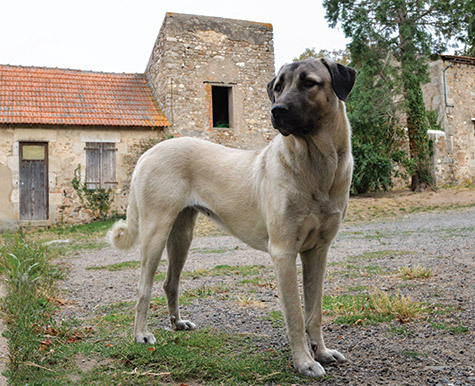






Anatolian Shepherd Dog
 Overview
Overview
Overview of Anatolian Shepherd
With their rugged good looks and stature, it’s no wonder that the Anatolian Shepherd has appeared on the silver screen in movies like “Kate & Leopold” and “Cats and Dogs”. They are one of the most majestic and imposing dog breeds out there (with males reaching up to 150lbs). In Anatolia, aka modern-day Turkey, the breed is known as Coban Kopegi (cho-bawn ko-pay) which translates to "Shepherd's Dog" because they are supreme livestock guardians. And to this day, can be seen defending their territory and protecting their flock in some of the world's oldest pastoral societies. Even though the Anatolian Shepherd has likely been around for thousands of years (since ancient Babylonia), the Turks never exported them until the 20th century because they were considered too valuable. The breed's history in America begins in the years immediately leading up to World War II, when the Department of Agriculture imported a pair of Anatolian Shepherds from Turkey to participate in the top-secret "Sheepdog Project" whose objective was to determine which dog would be best suited for working on American sheep pastures. After the pair of Anatolians gave birth to a litter of 12 puppies, they soon grew so big that they ate the entire project out of house and home. The experiment was shut down, and the dogs quietly sold (as not to offend the Turks). Then these pooches remained virtually unheard of until the Endangered Species Act (ESA) was passed in 1973 and there was a sudden need to control endangered predators without killing them (like the Cheetah conservation project in Namibia, Africa). The solution was to use livestock guardian dogs like the Anatolian Shepherd who would rather intimidate predators than fight them. This pooch's short, dense double coat is well equipped to protect them from blistering heat as well as sub-zero temperatures.
Common Health Conditions & Recommendations for Anatolian Shepherd
Demodectic Mange:
If your dog has a weakened or compromised immune system, they can develop demodectic mange. Mites can be passed from mother to puppy and present as patches of red, scaly, skin with hair loss on the head, neck and legs.
Recommendations for Demodectic Mange in Anatolian Shepherd Dogs:
Common Health Conditions & Recommendations for Anatolian Shepherd
Elbow Dysplasia:
Similar to hip dysplasia, this is also a degenerative condition. It's believed to be caused by abnormal joint formation. The severity can vary from arthritis to total lameness in the front legs.
Recommendations for Elbow Dysplasia in Anatolian Shepherd Dogs:
Common Health Conditions & Recommendations for Anatolian Shepherd
Ear Infections:
Like many breeds, Anatolians may develop ear infections so pay special attention to their ears to keep their ears free of debris and dark wax.
Recommendations for Ear Infections in Anatolian Shepherd Dogs:
 Personality
Personality

Most Anatolian experts agree that while these pups can bond deeply to their adored human companions, they are not 'pets' like many other dog breeds. Bred for millennia for their instinct to take care of themselves and the flock without needing instruction, the Anatolian Shepherd’s protective nature makes them capable of driving off the largest of predators (especially with that booming bark), but their self-reliant personality requires consistent training and socialization by an experienced owner. Anatolians may be sensitive to anesthesia so make sure to let your vet know if your pup has to go under the knife. These ancient dogs have remained relatively unchanged from their ancestors and many Anatolians still work as ranch dogs today, protecting every kind of flock from sheep and goats to ostriches and llamas. The Anatolian Shepherd could be your ideal four-legged companion if you want a good-looking pooch with a calm demeanor and grade A protection instinct.

 USD
USD
 Canadian Dollars
Canadian Dollars
